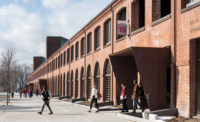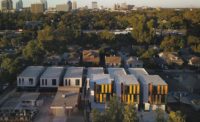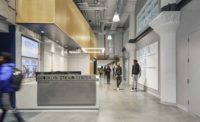Dotted with tumbledown relics of urban Americana—empty storefronts with faded signs; vacant lots and factories; the occasional retro diner—it might be surprising to learn that Worcester, Massachusetts, is New England’s second-most-populous city; the once thriving industrial town was largely abandoned when its manufacturing jobs dissolved or migrated elsewhere in the decades following World War II. But amid this blight, a robust downtown core shows signs that things have been changing; tech and biomedical businesses have established a foothold here, generating new construction and services in this affordable alternative to Boston, just a 45-minute drive to the east. Among a slew of publicly funded projects, a new visitors center embraces the city’s forward-thinking agenda, seeking to reclaim a rich legacy tarnished by years of economic and environmental freefall.
Additional Content:
Jump to credits & specifications
The Blackstone Visitors Center—an 11,000-square-foot steel-and-glass building bookended by outdoor recreational space—sits on a 4.5-acre sliver of land flanked by train tracks and busy thoroughfares, and divided by the Blackstone River, which flows from Worcester down to Providence, Rhode Island. From the mid-1800s up until the 1970s, the site was home to the Washburn & Moen Company, a prosperous metal and wire manufacturer that produced steel cable used for, among other things, the Brooklyn Bridge.
The project is the latest of seven visitors centers to be built along the 48-mile-long route that follows the river, known as the Blackstone Heritage Corridor; its completion coincides with that of the northernmost phase of the adjacent Blackstone Bikeway trail, an ongoing project that, when completed, will serve as a major recreational resource as well as an alternate mode of transportation, connecting New England’s second- and third-largest cities. Recent initiatives to revitalize the region—widely recognized as America’s industrial birthplace—are the product of three decades of public investment aimed at cleaning up the river, once one of the most polluted in the country, and restoring the historic properties along its banks.
The diminutive one-story visitors center has quickly established itself as a valuable amenity for bicyclists using the path, as well as a venue for various community programs and for events run by the local college and financial supporter, Holy Cross. Its main public space, an airy, light-filled gallery lined with douglas fir, features rotating exhibits and interactive displays that highlight Worcester’s culture, and bring awareness of the region’s illustrious history. “One of the main purposes is to bring people in to tell them to go someplace else,” Devon Kurtz, executive director of the Blackstone Heritage Corridor, has said. The Heritage Corridor, along with the Department of Conservation and Recreation (DCR), both have offices in the building.
For Boston-based designLAB, completing the project proved to be a test of endurance. The firm first became involved in 2008, when it was selected to transform the last of the three original brick-and-steel buildings remaining on the site into a facility that would house the Blackstone Visitors Center and the Worcester Historical Museum. In 2010, the team had just completed construction documentation when a fire destroyed the old structure, leaving no salvageable remains. The next year, a study commissioned by the National Park Service gave the architects the opportunity to envision how a stand-alone visitors center (minus the museum) could work on the now vacant site; the team then submitted a new RFP to build the project, which they were again awarded.
Where the previous project occupied the northern edge of the site, this blank slate allowed the team to place the new facility to the south, across the narrow river bend, for better visibility from the adjacent highway. This move also enabled the building to function as a hinge between the two main recreation spaces: an open field next to the beginning of the bike path, and a pavilion for outdoor concerts and events on the other side (PVs atop this structure will provide an estimated 70 percent of the building’s electricity, say the architects). According to partner Sam Batchelor, one of the main challenges was linking these three elements to create a coherent whole at a pedestrian scale. As a solution, the team conceived a procession of steel frames that form a 40-foot-wide by 640-foot-long “Heritage Walk”; this walkway passes alongside the building to extend over a newly constructed steel-grate bridge above the river. In addition to creating a sense of continuity across the whole site, the frames support lighting and other infrastructure for special events and performances.
While the overt use of steel here pays homage to the original buildings by nodding to their industrial past, so, too, does the use of brick, reclaimed from local historic mills and employed for the visitors center and along parts of the Heritage Walk. The goal, says designLAB founding partner Robert Miklos, was to create an “invented archaeology.” “We wanted to reference without recreating,” explains Batchelor. Where not fully glazed, the building’s front features a wall made of these bricks, held in place only by gossamer gabion baskets—another reference to the wire-manufacturing industry. This steel latticework is also used as screening on the facade, and appears again inside as sliding exhibition panels. The most prominent connection to the site’s heritage is the building’s sawtooth profile, which riffs off the original factory roofline but in a modified form that admits less daylight. To simplify construction, the architects devised a design that mimics the form but functions as a traditional roofing system, with a continuous spine. To get this effect, the team took a standard shed roof, and, out of this, they popped triangular clerestories for a serrated expression.
Over a decade in the making, the visitors center is a long-anticipated amenity and symbol of change for this corner of Worcester that has been among the last to benefit from recent improvements. And, situated at a major entry point to the city, near the Massachusetts Turnpike, it has quickly become a new gateway and a source of pride for local residents. “It’s a critical piece of the revitalization effort,” says Batchelor. “Having something that celebrates the city’s heritage while also recognizing its tremendous transformation emphasizes how it is repositioning itself as a great place to work and live.”
CreditsArchitect: designLAB Architects — Sam Batchelor, Robert Miklos, Mary Ann Upton, Jason Van Ypren, Austin Ward, project team
Engineering: Structures Workshop (structural: building); AECOM (structural: bridge, civil, landscape); Architectural Engineers (mep/fp)
Consultants: Landworks Studio (landscape); Exp Design (exhibit)
General contractor: Daniel O’Connell’s Sons |
SpecificationsRoof panels VMZINC
Wire screens GKD
Glazing Guardian |












Post a comment to this article
Report Abusive Comment